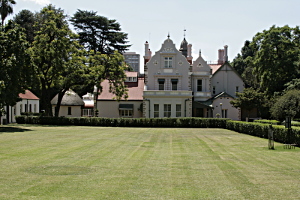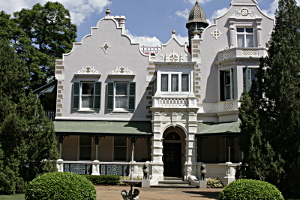Melrose House: A Glimpse into Pretoria's Historical Past
Nestled in the heart of Pretoria, opposite Burgers Park, stands the stately Melrose House, a testament to the city's rich history and a reflection of its architectural evolution. With its Victorian and Edwardian influences, the mansion tells a tale of prosperity, war, and restoration.
Built in 1886 by George Jesse Heys, a thriving Pretoria businessman, Melrose House derives its name from the renowned Melrose Abbey in Scotland. However, it wasn't just its stunning architecture that catapulted this house into the annals of history; its significance is also deeply intertwined with the Second Boer War.
In June 1900, following the invasion of Pretoria, Lord Roberts commandeered Melrose House, transforming this majestic residence into the headquarters for the British forces. For over 18 months, this mansion echoed with strategies, decisions, and instructions that played pivotal roles in the war. Its relevance in this historical conflict culminated on 31 May 1902 with the signing of the Treaty of Vereeniging within its walls. This treaty signified the end of the Second Boer War, forever etching Melrose House's place in history.
Decades later, in 1967, the Pretoria City Council, recognizing the historical importance of Melrose House, acquired the property and its contents for R300,000. This acquisition paved the way for a comprehensive restoration, culminating in its opening as a museum. On 17 May 1971, Charles Robberts Swart, the State President of South Africa, bestowed upon Melrose House the status of a national heritage site.
The mansion today stands as a historic house museum, drawing visitors into its captivating world of architectural transition from Victorian to Edwardian styles. As one wanders through its rooms, the colorful stained glass windows, vibrant carpets, ornate ceilings, and fireplaces capture the imagination. Paintings by renowned English artists grace the walls, while precious porcelain ornaments, most of which originally belonged to the Heys family, decorate the rooms. Of particular significance is the room housing the table on which the Treaty of Vereeniging was signed, allowing visitors to step back in time and witness a pivotal moment in South African history.
However, not all moments in the history of Melrose House have been positive. On the night of 23 May 1990, a sudden explosion rattled the very foundation of the mansion. At 9.30pm, the historic house was rocked, causing extensive damage. Fortunately, the blast resulted in no injuries. As investigations into the incident unfolded, the Orde Boerevolk came forward during the proceedings of the Truth and Reconciliation Commission, admitting their responsibility for this act of destruction.
Melrose House, with its grandeur and historical significance, continues to be a beacon of Pretoria's past, inviting visitors to traverse its corridors and relive moments that have shaped South African history. From its construction to its role in the war and its subsequent transformation into a museum, it stands as a testament to the city's resilience, evolution, and deep-rooted heritage.

